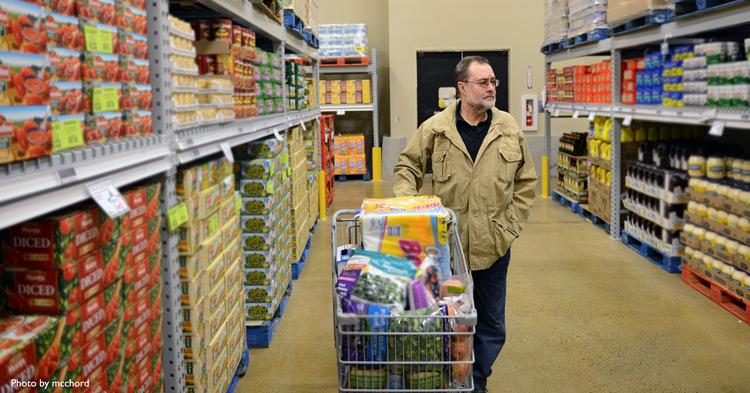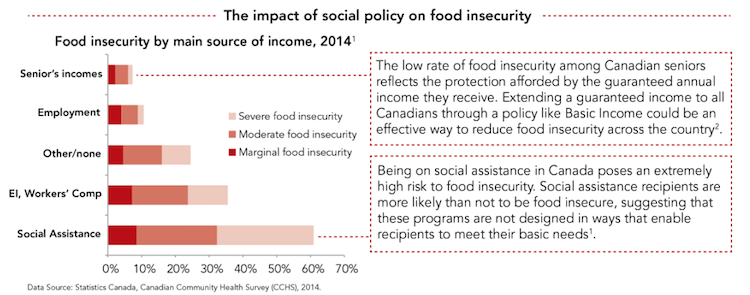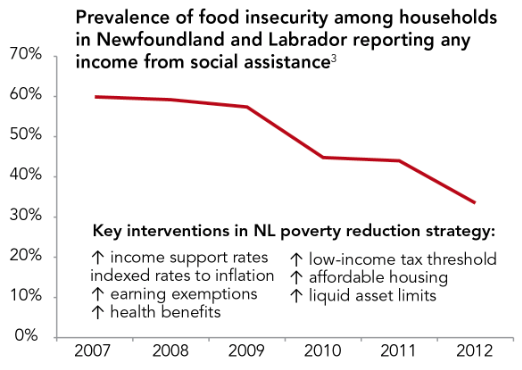A Basic Income and a Food Security Strategy: Is Ontario tackling food insecurity?

Following a consultation period consisting of online engagement and regional fora, details of a three-year pilot project on basic income were announced last week by the Ontario government. The project aims to study the impacts of a basic income on a few key areas, including food security, health and housing.
What is basic income?
Basic income is a form of social assistance that creates an income floor beneath which no one can fall: Ontarians who participate in this pilot will have their incomes topped up to approximately double the current welfare rates. Basic income has gained significant traction recently among economists, politicians and social activists as a simpler, more effective and less stigmatizing response to poverty than current social assistance programs.
Basic income has also been considered in Quebec, which has been studying the measure and has hinted at a rollout, and PEI, where a motion to develop a pilot project was unanimously passed. While many groups, including Food Secure Canada and Community Food Centres Canada, have called on the federal government to consider a basic income for all Canadians, Finance Minister Bill Morneau recently stated that this is not a current priority.
The Ontario pilot will be launched this spring in Hamilton, Brantford and Brant County and in Thunder Bay and the surrounding areas, followed by Lindsay in the fall. These communities were chosen in order to study the impacts in urban, rural and urban/rural-mixed areas. Participants aged 18-64 living on a low income will be randomly selected and invited to apply. (Seniors, who already receive forms of basic income from the federal government through Old Age Security and the Guaranteed Income Supplement, have been excluded from this pilot. Research from the University of Calgary’s School of Public Policy has shown that, upon becoming eligible for these programs at the age of 65, people’s risk of food insecurity is halved.)
While Canada does not have an official poverty line, the payment has been set at 75 per cent of Statistics Canada’s Low Income Measure: up to $16,989 for a single person or $24,027 for a couple, with an extra $500 per month for people with disabilities. In order not to disincentivize work through clawbacks on earned income, as is currently done for social assistance recipients, benefits will only decrease by 50 cents per dollar earned through work.
A separate First Nations Basic Income Pilot is also being planned, though is in the early stages of its development. As the Canadian Community Health Survey is not administered on reserves, this pilot will have to deal with the lack of baseline data on food insecurity and other important measures.

Ontario’s Food Security Strategy
Also announced by the Ontario government this month is a discussion paper to frame consultations on a Food Security Strategy, which is set to launch this fall. The strategy envisions “a province where every person has access to high-quality, safe, nutritious and culturally appropriate food, to support them in leading healthy and active lives” and recognizes the need for action to assist the province’s 595,000 food-insecure households.
The discussion paper proposes four areas of focus, namely: supporting community-specific solutions; creating a shared vision for collective impact based on the best available knowledge; increasing economic access to food; and finding innovative solutions.
So what does this all mean?
Ontario’s basic income pilots, food security strategy and poverty-reduction strategy are signs the Province is starting to take poverty and food security more seriously. As with all government strategies, however, these will only be effective if they come with adequate resources.
“The pilot is a really important first step,” says Valerie Tarasuk, a professor at the University of Toronto’s Department of Nutritional Sciences and Principal Investigator at PROOF. “The province has clearly identified food security as a key outcome to evaluate. Everything we know would suggest that they will see improvements in household food security as a result of this intervention.”

PROOF investigators have put forward overwhelming evidence that income solutions are needed to address food insecurity. While every Canadian province save British Columbia has a poverty-reduction strategy, few have meaningfully impacted food insecurity rates. Newfoundland and Labrador’s strategy, however, which raised social assistance rates and indexed them to inflation, importantly contributed to a drop in the province’s food insecurity rates from 15.7 per cent in 2007 to 10.6 per cent in 2011.

Whether Ontario’s basic income pilot will have a similar impact depends on what becomes of it. Will the project, which is set to reach only a relative few, be expanded to all low-income Ontarians after the next election by what looks increasingly likely to be a Progressive Conservative government? Or will it meet the fate of Manitoba’s 1974-1979 experiment and fall prey to a change in leadership?
As for the Food Security Strategy, it is too early to tell whether it will do much to lower food insecurity rates in Ontario. The provincial budget, released last week, poured billions of much-needed dollars into health care, launching a pharmacare program for Ontarians under 25. Social assistance rates, however, were raised a paltry two per cent, which, considering that the average cost of rent in Toronto has increased by $300 in six months, will be of little help to many.
Nonetheless, these will be interesting policies to watch for Canadians concerned with the rising rates of food insecurity and will provide important lessons to other provinces and territories, and to the federal government.
Share your thoughts:
- Log in to post comments

